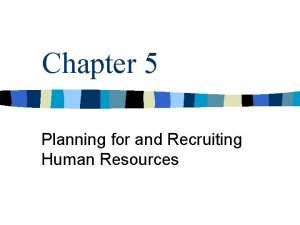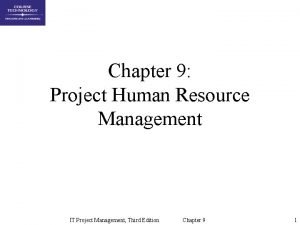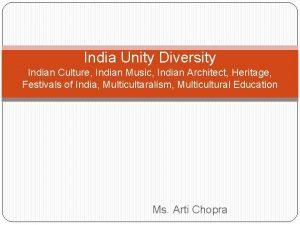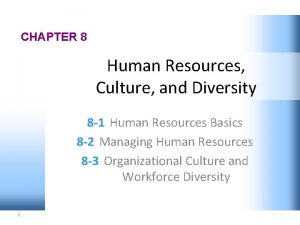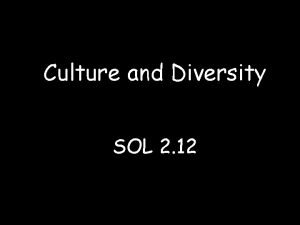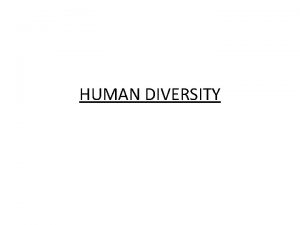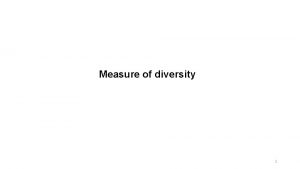Chapter 8 Human Resources Culture and Diversity 8














- Slides: 14

Chapter 8: Human Resources, Culture, and Diversity

8 -1: Human Resources Basics Key Terms: Workforce- made up of all the people 16 years and older who are employed or who are looking for a job. Downsizing- a planned reduction in the number of employees needed in a firm in order to reduces costs and make the business more efficient. Outsourcing- removes work from one company and sends it to another company that can complete it at a lower cost.

The Occupational Outlook Handbook (OOH) The OOH offers up to date info about the U. S. workforce. Two Major Types Service-Providing Industries Goods-Producing Industries

Employment Projections for Occupational Categories Professional: 16. 8% Percentage Change Service: 13. 8% in Employment, Construction & Extraction: 13. 0% 2008 -2018 Management, Business & Financial: 10. 6% Installation, Maintenance & Repair: 7. 6% Office & Administrative Support: 7. 6% Sales: 6. 2% Transportation & Materials Moving: 4. 0% Farming, Fishing, & Forestry: -0. 9% Production: -3. 5%

Human Resources Activities Planning & Staffing • Job analysis • Recruitment & Selection • Job Placement Performance Management • • • Performance assessment Performance improvement Managing promotions, transfers & terminations Compensation & Benefits Employee Relations • Wage & salary planning • Benefits planning • Payroll, benefits & personnel records management • Health and safety planning • Labor relations • Employment law and policy enforcement • Organizational development

8 -2: Managing Human Resources Key Terms Job Analysis- a specific study of a job to identify in detail the job duties and skill requirements. Compensation- the amount of money paid to an employee for work performed. Salary & Wages- direct payment of money to an employee for work completed. Benefits- compensation in forms other than direct payment. Incentive systems- connect the amount of compensation to the quality or quantity of an employee’s performance. Promotion- the advancement of an employee to a position with greater responsibility. Transfer- the assignment of an employee to another job in the company with a similar level of responsibility. Termination- ends the employment relationship between a company and an employer.

Classifying Employees The company must decide whether the person to be hired will be permanent (one whom the company makes a long-term commitment) or temporary ( one hired for a specific time or to complete a specific assignment). Because permanent employees feel that they are a part of the business, they are often more productive than temporary employees.

Determining Job Requirements Before starting the hiring process, human resources staff studies the work that must be done in the job. Specific information about each job is needed in order to hire people with the right skills. That information is often collected by completing a job analysis.

The Application Process Most companies ask prospective applicants to fill out an employee application. The applications gather personal information, information on education, and work experience history. It may also ask for specific skills related to the job and contact information for people who can serve as references.

New Employee Orientation The final step in the hiring process is to help the new employee get a good start in the company. As a part of the orientation, the new employee will meet with human resources specialists to complete all of the paperwork needed to receive pay and benefits. In turn, the company will have a complete employee record.

The Evaluation Process Performance evaluations focus on the specific job duties of each employee. They also review the important work qualities expected of all employees. Those qualities include factors such as communication, interpersonal relationships, quality and quantity of work , and ethical behavior.

The Evaluation Conference After the manager completes the evaluation form, a conference is scheduled with the employee. The purpose of the conference is to review and discuss the results of the evaluation and to plan for any needed performance improvement. Often, both the manager and employee are concerned about the conference.

8 -3: Organizational Culture and Workforce Diversity Key Terms Organizational Culture- the environment in which people work, made up of the atmosphere, behaviors, beliefs, and relationships. Work Environment- the physical conditions and the psychological atmosphere in which employees work. Labor Union- an organized group of employees who negotiate with employers about issues, such as wages and working conditions. Diversity- as it applies to the workplace is the comprehensive inclusion of people with differences in personal characteristics and attributes. Glass Ceiling- an artificial limit placed on minority groups moving into positions of authority and decision-making.

The End
 Chapter 8 human resources culture and diversity
Chapter 8 human resources culture and diversity Chapter 8 test human resources culture and diversity
Chapter 8 test human resources culture and diversity Diversity and human needs and development
Diversity and human needs and development Why is genetic diversity important
Why is genetic diversity important Genetic diversity vs species diversity
Genetic diversity vs species diversity Chapter 5 personnel planning and recruiting
Chapter 5 personnel planning and recruiting Sunrise enabler
Sunrise enabler Transformation process in operations management
Transformation process in operations management Difference between fixed and variable resources
Difference between fixed and variable resources Chapter 9 human resource management
Chapter 9 human resource management Chapter 27 human impact on earth resources
Chapter 27 human impact on earth resources Intro to human resource management
Intro to human resource management Chapter 9 human resources management
Chapter 9 human resources management Chapter 10 managing human resources
Chapter 10 managing human resources Unity in diversity in indian culture
Unity in diversity in indian culture





